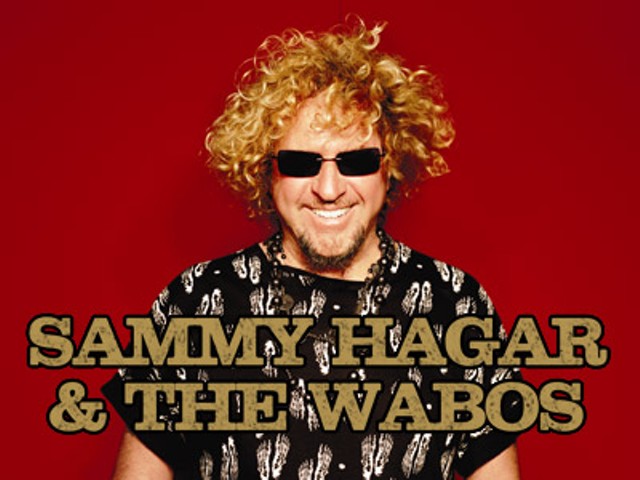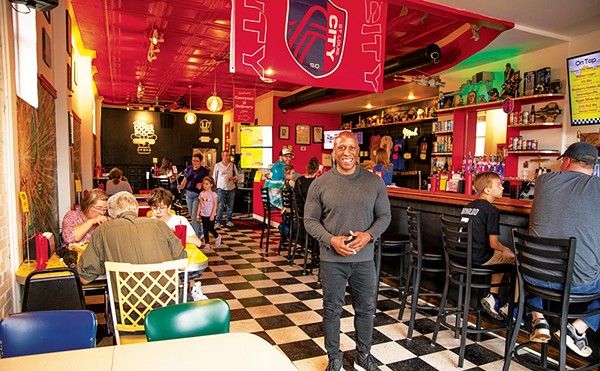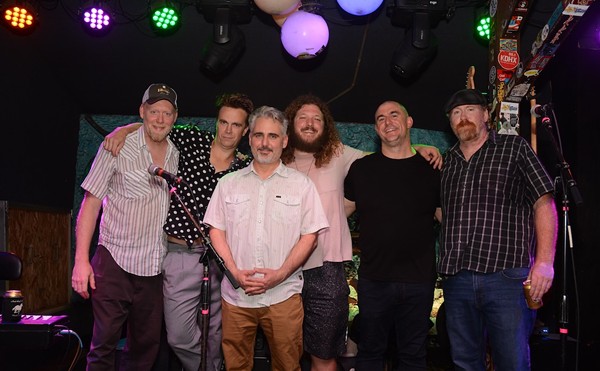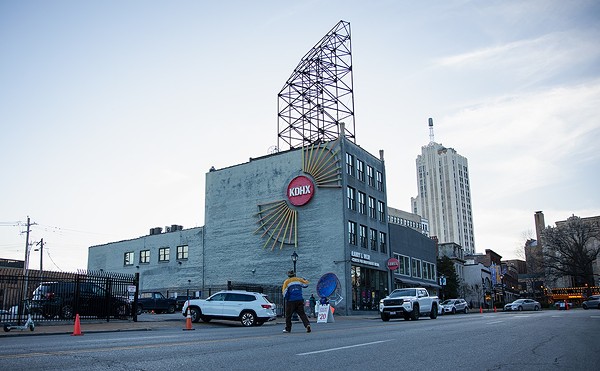The Chicago Sun-Times’ blog recently published an interesting piece by noted music critic Jim DeRogatis, in which he attempts to prove that ‘90s Alternative Nation darlings (and specifically Chicago acts Urge Overkill, Veruca Salt, Liz Phair and Smashing Pumpkins) resemble the baby-boomer acts they once railed against. DeRogatis says that although it seemed implausible that these groups would become like “the artistically stilted, cash-hungry or pathetically reactionary dinosaurs that preceded them,” they did.
Urge Overkill, "Positive Bleeding," Letterman 1993:
On the surface, the theory isn’t a bad one; just think about how many ‘90s acts have reunited (or still tour) on the strength of one or two lame hits. But the methodology he uses to prove his point – not to mention the factual backbone of the piece – is rather flimsy.
In fact, it feels like the piece sees ominous signs that just don’t exist. For starters, Urge Overkill’s official website isn’t shut down, something the article claims is evidence of disaster; the site can be found right here. Ex-Veruca Salt member Nina Gordon’s musical website might be inactive because she’s busy being a mom. As she said in a 2007 MySpace blog, “i figured i should let you guys hear something new (ish), since i have been super incommunicado, and musically un-productive since ivy was born.”
And then there’s Liz Phair. DeRogatis says, “[Phair] recorded with the bubblegum-pop production team the Matrix and tried to reinvent herself as Sheryl Crow Mach II with a self-titled release in 2003 and "Somebody's Miracle" in 2005. Those discs primarily succeeded in alienating Phair's original fan base, while scoring only modest success on the charts and radio play lists. So earlier this year, she tried to win back the faithful with a "15th Anniversary Tour" where she played all of her first album.”
"Supernova":
The article considers these 2008 shows evidence of Phair’s modern irrelevance because they grossed more money, on average, than she did on a 2003 tour. According to a Billboard article DeRogatis quotes, “two June "Guyville" shows, at San Francisco's Fillmore (1,298 capacity) and Chicago's Vic Theatre (1,400), were sellouts, with an average gross of $31,787. In contrast, Phair's 2003 tour posted an average gross of $18,174 from 17 shows reported to Billboard Boxscore.”
Interesting that at both 2008 shows, tickets were $25 – but a quick Nexis search of 2003 solo-show ticket prices brought up prices generally ranging from $15 to $18. Gee, wonder why Phair made more money this time around? It wasn’t just nostalgia inflating those grosses.
Also conveniently missing from DeRogatis’s equation is the fact that 2003’s Liz Phair allegedly sold as many copies as Liz’s other solo records have – and that album’s “Why Can’t I?” is her highest-charting single ever, a Top 40 hit at No. 32 that went gold. (“Extraordinary” also landed high on other charts.) Although critics might not have liked her Matrix-ed up persona, it wasn’t the unmitigated commercial disaster people might have thought (or hoped).
Even more intriguing is how the article implies that Sonic Youth's Daydream Nation "Don't Look Back" shows were mere cash grabs. DeRogatis says:
If an act is still a vibrant creative force, why would it want to tour and play one of its older albums in its entirety? The answer is obvious, according to an article in Billboard last August: At 11 shows in 2006 featuring a mix of new and old material, Sonic Youth grossed $315,305 in tickets sales. In 2007, during only three shows at which it played its classic "Daydream Nation" album, the band raked in $496,791.
But it's not so obvious that it's all about cash. In an interview with Spin magazine, vocalist Thurston Moore sounds conflicted about doing the Nation shows. He does admit that the band earned more money from doing these shows -- first because they were all Daydream Nation and second because they were at summer festivals, "which is always how you make a little money in the summer, to get you through your year."
But Moore says the band at first balked at the idea, because "a festival audience is a bunch of drunken people coming out and hearing these truncated sets by these bands, one after the other, and there's no soundcheck. Usually, it's on the precipice of being a disaster. Something like Daydream Nation might not work in a setting like that." Moreover, he was also worried about precisely what DeRogatis implies the band was doing: relying on nostalgia and forsaking progress.
It took a lot of influence for me to do it. I thought it would be taking up too much time from us doing something new and progressive.... But then I started getting really into figuring them out, and where I was as a guitar player and as a band person in 1988, in that scene. And it was kind of inspiring, and it brought back this groundedness in this music existing at a point when we didn't have any responsibilities, like parenthood -- we were really on the loose. We were just trying to get out of the dishwashing business, and maybe be able to stay in the van all the time and pay bills that way, if we could. There's a certain glory in that innocence, and that feeling was there when we were reconstructing this music again.
"Teenage Riot"
The other problem is that those SY show grosses – which originate in the same Billboard article that had the Phair concert grosses – are misleading. For starters, that story bases its monetary information on just three shows (out of seventeen Daydream Nation performances), including a “two-night stand” in Berkeley, California. According to Sonic Youth’s official tour chronology, that never actually happened; the band only played one show in Berkeley.
Second, Sonic Youth toured constantly in 2006, both as headliners and with the Flaming Lips or Pearl Jam, in venues big and small. So what eleven dates were these stats using? The gross for the particular eleven dates used as a sample size could vary wildly, depending on attendance, ticket price and production costs.
It’s unfair and manipulative (not to mention unscientific and beyond random) to compare a solo tour to the Daydream Nation shows. It’s even more ludicrous to use Sonic Youth as an example of how ‘90s bands are reactionary or just out for nostalgia -- especially because the band continues to make new music (a new disc is due on Matador in 2009) and its members release side/solo projects. Sonic Youth is the last band on earth most would accuse of being a lackluster creative force.
In contrast, many often consider Smashing Pumpkins a lackluster creative force – especially after 2007’s Zeitgeist. DeRogatis admits Zeitgeist is lukewarm, but expresses more scorn for the band’s “strictly-for-the-money Indiana casino gig earlier this year and a recent deal with the silly but absurdly popular Guitar Hero video game.”
First, newsflash: Many bands do casino gigs these days, mainly because the money is so good. “Credible” bands such as TV On the Radio, Rufus Wainwright and Neko Case have played casinos in Kansas City; Nada Surf and the Lemonheads played casinos here. This year’s Pumpkins tour has also included gigs at casinos in Connecticut and Atlantic City.
And besides, that Indiana gig wasn’t exactly a hits tour de force. Although “Bullet with Butterfly Wings,” “Tonight, Tonight” and “Today” make appearances, countless hit singles – “1979,” “Rocket,” “Landslide,” etc. – didn’t. In fact, the current Pumpkins setlist has a ton of new material, as have all of the other shows on this tour. After the St. Louis show next Wednesday, we’ll have a better idea of the quality of these recent tunes, although various reports say the material is experimental. While not always creatively successful, Billy Corgan and co. are hardly artistically stilted.
"Today"
And as for Guitar Hero, one commenter pointed it out best: “Like it or not, the world has changed. The most receptive audience for rock music today is the same ppl playing the guitar hero and rockband games.” It’s absolutely smart business to diversify where your music is heard – and short-sighted to dismiss the impact and influence Guiter Hero has had on album sales. Long-term studies are inconclusive, but scattered bits of empirical evidence do seem to prove that video game exposure is a good complement (or supplement) to radio.
The DeRogatis article ultimately operates under an outmoded premise and old-model definition of superstardom -- namely, that success is measured by album sales and concert tickets sold. All four Chicago acts might not have sustained big-selling careers, but they received heavy alternative radio airplay, and all but Phair were in heavy rotation on MTV. Curiously, DeRogatis doesn’t mention MTV at all in context of these acts. Back in the early- to mid-‘90s, MTV still aired videos, and had the power to shape musical culture. And while the bands might not have become global superstars, they were a solid presence in music-video-land -- and that influence can’t be overestimated.
DeRogatis might himself be a bit guilty of the same nostalgia-mongering he chides these bands for doing. The acts he cites might be past their commercial apexes, but placing acts from 1993 in 2008’s music industry is foolish. Why should we expect the bands from 1993 to replicate their commercial success from that time again – especially because what constitutes success is now so broad and changeable? What if these bands are just making music because they find it – gasp – fun?
More important: Why should we expect the bands from 1993 to remain creative dynamos in 2008? Bands form and split, make good records and make bad records. There’s a reason why very few bands become vibrant career artists who continue to evolve and innovate in the long-term. But that’s not a terrible thing at all; this Darwinian life-death cycle keeps the music industry fresh.
And though the article’s scope is purposely limited to Chicago for narrowing purposes, think about this: Both Radiohead and Bjork released their debut albums in 1993.





